22 Little-Known Tips to {Really} Clean Your Home
This post may contain affiliate links, including those from Amazon.com, which means we earn a small commission off your purchases. And here's the thing: We only mention services and products that we think are truly worth your attention, whether they're free, paid, or otherwise. This site relies on YOUR trust, so if we don't stand behind a product 110%, it's not mentioned. Period.
Non-toxic cleaners are the foundation of a natural, non-toxic home. So make your own!
Making your own cleaners is one of the simplest – and most important – changes you can make to make your home a healthier, happier place. These simple recipes are ones you can easily make over and over again.
The feeling of knowing your home is truly clean is plain-ol' deep-down satisfying, so today I offer a handful of my favorite little-known tips to clean those areas that typically get overlooked (or tips for making common cleaning jobs easier).
Two notes for getting deep-down clean, naturally
One, I mention all-purpose cleaner in a number of places throughout this article. I use the recipe that's located in our free download, Clean, Naturally!, (there's a big link to download those recipes on multiple places around this page) but you may certainly use your favorite all-purpose cleaner if you prefer to skip that recipe.
And two, even if you've never had children and don't intend to, I highly recommend purchasing at least a dozen heavy-duty, high-quality prefold cloth diapers, as they are the best cleaning cloths for spills, dusting, leaking pipes, buffing cars, and pretty much any other cleaning application you can think of. They will last you for YEARS. These are the ones I most highly recommend – for babies, cleaning, and otherwise!
I love high-quality microfiber too and put various pieces of outgrown clothing to good use as rags, but there's just nothing like a good, soft, absorbent diaper to do the job right.
With that, happy cleaning!
Bathroom
Tip #1: For faucets that really shine, wipe down faucets and similar surfaces first with a slightly damp cloth, then buff with a dry towel. Afterward, toss it in the laundry bag and place out fresh towels.
Tip #2: Use floss to get the grimies out of anywhere around your faucet or toilet handle that look, well… grimy.
Tip #3: Save old toothbrushes to scrub small and hard-to-reach places, such as shower door rails, the tops and bottoms of baseboards, heater vents, and those pesky fan covers that are always hard to reach.
Tip #4: To clean showerheads, pour an ample amount of white vinegar into a plastic produce bag or plastic zippered bag (large enough to fully submerge the showerhead nozzle) and tie it in place for an overnight soaking. Remove it in the morning and run the water to rinse. You can also use one of your saved toothbrushes from Tip #3 to scrub away loosened minerals and other build-up, if necessary.
Tip #5: Refresh plastic shower curtains and liners by placing them in the washing machine with a few old towels, which act as scrubbers to help get rid of soap scum and mildew. Wash on warm with a normal amount of detergent. Rehang to dry.
Tip #6: Scrub away soap scum and bathtub rings with pulverized eggshells or other natural abrasives you have around the house. A old loofah sponge also works wonders.
Tip #7: Clean your toilet brush by dumping 1 cup of washing soda, 1/2 cup hydrogen peroxide, and 1/2 cup white vinegar into the water of the toilet bowl and letting the brush sit in the mixture for several hours. Flush and rinse the brush in the fresh water, then let the brush dry by laying the brush across one part of the seat so that brush itself hangs over the water, then closing the lid to hold the brush in place.
Tip #8: Clear scum and build-up out of your drains by spooning 1 cup baking soda into the drain, trying to get it as far down the pipe as possible, then pour 1 cup white vinegar down the drain and let it fizz for 5-10 minutes. Set a bowl under the tap and run it until the water is as hot as possible, then remove the bowl and let hot water run down the drain for 30-60 seconds.
Tip #9: To make mirrors shine, use vodka or isopropyl alcohol. I make my glass and window cleaner with 1 part vodka, 1 part white vinegar, and 2 parts distilled water. Spray, wipe, then buff with a lint-free cloth for a perfectly streak-free shine.
Tip #10: Sliding shower door tracks can be infuriating to get really clean, but no more! After you've wiped away as much gunk as you can with a sponge or a cloth, spritz the tracks with all-purpose cleaner, then place a thin, sturdy cloth over a flat-head screwdriver or a pointed chopstick and scrub all the way into the crevices along each side. You can sprinkle very lightly with baking soda if you need a bit more oomph. I like to finish this by running a cotton-tipped swab along the length of the crevice. Wipe and rinse until all the grime residue is gone, then spray lightly with WD-40 or rub with coconut oil for a smoother glide, if necessary.
Non-toxic cleaners are the foundation of a natural, non-toxic home. So make your own!
Making your own cleaners is one of the simplest – and most important – changes you can make to make your home a healthier, happier place. These simple recipes are ones you can easily make over and over again.
Kitchen
Tip #11: Clean and gently sanitize your wood chopping blocks and cutting boards by rubbing with a lemon or spritzing them with homemade bleach. If residue remains from the lemon juice, rinse it off after the wood is completely dry.
Tip #12: To clean the inside of grimy bottles and glassware that are difficult to clean (say, a wine bottle that's been used as a flower vase or a narrow-mouthed mason jar after a long fermentation), use uncooked rice. Sprinkle 1/4 cup of uncooked rice along with a few tablespoons of water and a small squirt of dish soap into the bottle, then cap and swish until the bottle is clean.
Tip #13: To polish stainless steel silverware and get rid of the tarnished look that builds-up over time (especially if you use a dishwasher rather than hand-wash), rub each utensil with a thick baking soda paste, then rinse and dry well.
And speaking of stainless steel, rub plain baking soda or our non-toxic kitchen cleanser all over the inside of your stainless steel sinks at least once a week to keep them spot-free and gleaming.
Tip #14: Descale kettles by filling them with equal parts white vinegar and water (use distilled water if you live in an area with hard tap water), bring to a boil, then let sit for several hours or overnight. Rinse well, then boil once with plain water to get rid of any lingering vinegar residue.
Tip #15: To remove the stubborn gunk on non-porous surfaces (such as the stove top), make a paste out of baking soda and hydrogen peroxide to scrub those stubborn splatters off. Let it sit for a few minutes before scrubbing, if necessary.
Tip #16: Use a toothbrush or used dental Sulcabrush to scrub wall splash tiles, grout, caulking, any crannies inside your refrigerator, and baseboards, especially near any tables or areas where food is often served or consumed.
Laundry Room
Tip #17: Remove long-term underarm stains and ring-around-the-collar by using crushed up digestive enzyme tablets or an enzyme-based cleaner, such as Branch Basics. (This is more a laundry tip than a laundry room tip, but I only tend to tackle this chore when I'm deep cleaning, so it's in my mental “spring cleaning” notes.)
Underarm stains are caused by the lovely mixture of sweat (which is salty), bacteria (which proliferate in warm, damp areas), body oils, and the dust and grime of everyday life. Bleaches don't tend to get these clean because the stains are mostly protein and fat in nature and bleaches merely whiten fabrics rather than actually locking onto those molecules to remove them, so you need enzymes to break them down instead.
To clean underarm stains that have been around a while, crush up a number of digestive enzyme tablets (these inexpensive ones will do just fine) and add water a teaspoon at a time, just until you form a paste. (If the piece of clothing in question is completely white, you could mix the enzymes with hydrogen peroxide as an alternative.) Rub the paste all over the stain and let it sit for 2-4 hours (longer as desired), then launder as usual. For even more potent enzyme action, use Branch Basics. (I simply adore Branch Basics, both as a product and as a company!)
Tip #18: Clean the inside of your top-loading washing machine by running a cycle on the hottest setting with the most water possible and for the longest setting available. Once the water has filled, add in a quart of white vinegar and 1 cup of washing or baking soda, then let the mixture sit for about an hour before allowing the cycle to continue. Once the cycle has finished and drained, run the cycle again without any additives (i.e. no vinegar, no bleach – just water).
You can do the same thing with your front-loader, just add the vinegar and baking soda in via the detergent drawer and add (obviously) only as much as the cups can hold – it likely won't be a quart!
Meanwhile, use a toothbrush to clean around all the detergent cups and the base of the lid (top-loader).
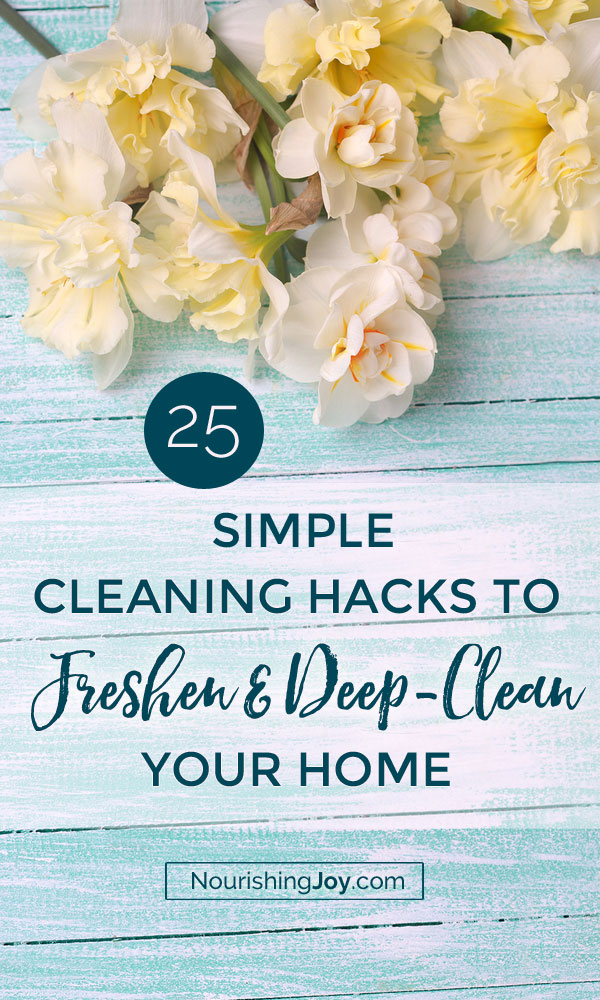


Common Areas
Tip #19: Use pillowcases to dust ceiling fans so that dust falls into the cases rather than in your face. Spray the pillowcases lightly with all-purpose cleaning spray, then place a pillowcase over each wing of the fan. Cover the fan switch with tape so the fan can't be turned on while you're dusting, then rub the top and bottom of each wing with the pillowcase to clean it. When you're finished, slip the pillowcases off and toss them in the wash. If your ceiling fan is too high to reach, use an extended pole duster, such as this one. (Wear a shower cap while cleaning, if desired.)
Tip #20: Remove permanent marker, crayon, or dry erase marker from wood surfaces by partially wetting a cloth with isopropyl alcohol (aka rubbing alcohol) and rub over the mark to effectively erase it without damaging the wood or its finish. (Definitely test this on an inconspicuous place first, as while it has always worked for me without damage, I haven't had opportunity to try it on every type of wood with every type of finish in every type of climate.) This has also worked for me on painted walls, but again, try in an inconspicuous area to see if it will work for you.
Side note: Branch Basics will also work well in this application! Ask me how I know…. ::sigh::
Tip #21: When dusting, don't dry dust, as it's basically just moving dust around, and thus wasted time. Instead, use a very very slightly damp cloth with a mild soap solution (1 tablespoon liquid castile soap per 1/2 gallon of water) or our homemade dusting spray to dust and buff at the same time. It will be healthier AND more pleasant to the eye!
Tip #22: To remove stains from carpets, use copious amounts of salt. If possible, treat the stain as soon as it happens by blotting up as much of the stain as possible, then pouring about a half-an-inch of salt on top of the stain. The salt will wick up the liquid, effectively removing it from the carpet fibers. Let it sit for 1-5 days, adding more salt as necessary. When the salt is dry, break it up and vacuum well. If the stain has already dried, re-moisten it by spritzing it heavily with water, then blot and pour on the salt.
If the stain is in an area where it's not appropriate to have salt sitting for a full day or more, slowly pour soda water over the stain, letting it bubble between each drizzle and blotting up the liquid as you go. An old prefold diaper works beautifully for this.
And of course – like many of our handy tip posts, like our ideas for 31+ Non-Toy Gift Ideas for Children – I can't help but add in a few more tips as time goes by!
Tip #23: To disinfect and freshen up your mattresses, spray them with vodka. Vodka absorb odors and evaporates quickly, so it's a great trick each time you change the sheets – or even just a couple of times a year. You can also add a few drops of essential oil to the spray if desired. A pretty & super-sturdy Grove Collaborative glass bottle is perfect for this – just pour in the vodka, add your essential oils, and shake before you spray.
Tip #24: Another dusting tip – use a lint roller to dust cloth lampshades. Lampshades can be magnets for dust, dander, and pet hair, but they're notoriously difficult to wipe clean. So use an adhesive lint roller! Simply run it lightly over the lampshade a few times to grab all those dust bandits.
Adhesive types of lint rollers are also SUPER-handy when the kids have been working on projects with glitter, beads, or cutting paper into a million tiny pieces. We keep this one on hand, since they work really well and the handles are reusable, meaning less waste. Sanity-saver galore!
Tip #25: Use softened crayon to hide scratches in your hardwood floor. If you have scratches in your floor that make you cringe each time you see them, soften a crayon of the same shade as the floor by leaving it in the direct sun until it's pliable (or softening it for just a few seconds in the microwave), then rub it into the scratch. Use a credit card or other strong, flat tool to gently scrape away the excess wax, then buff with a soft cloth. The scratch will hardly be able to be seen, especially if the color match was perfect.
So, there you go – more tips that you can shake a stick at. 😉
Here's to clean, organized, and joy-filled homes!
Did you like this post? If so, be sure to read our post on
How to Make 27 Homemade Cleaners.
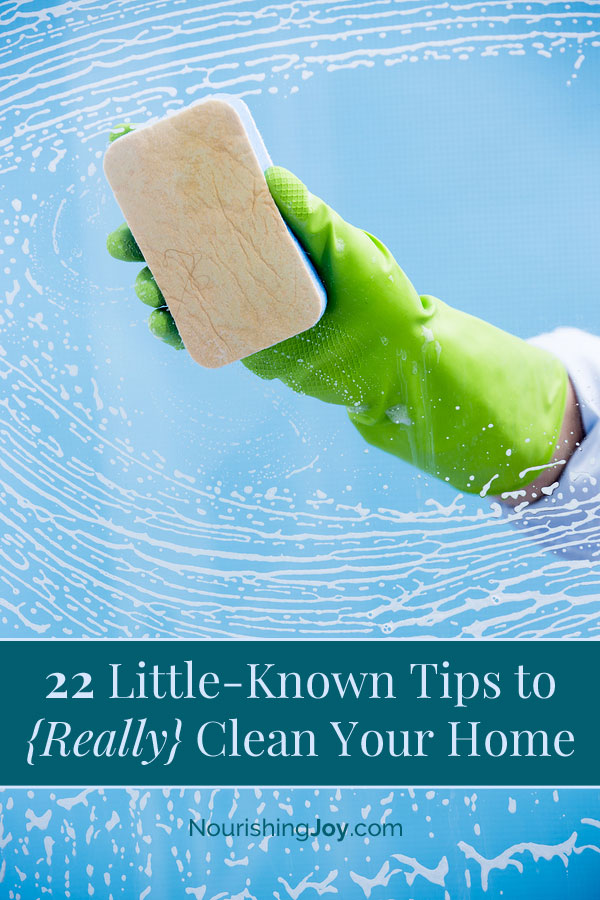


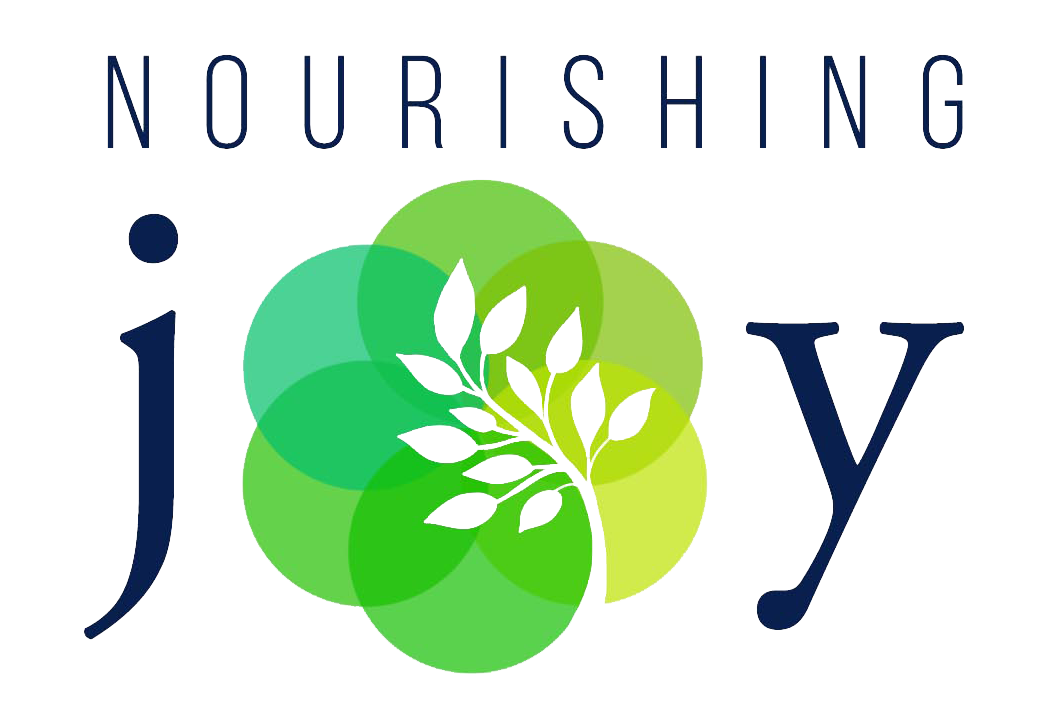

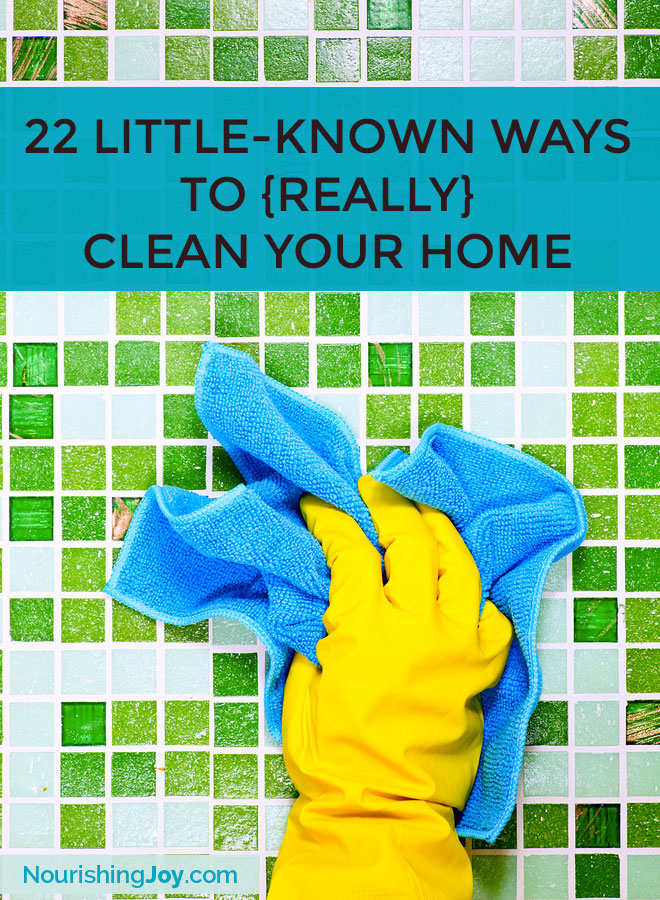
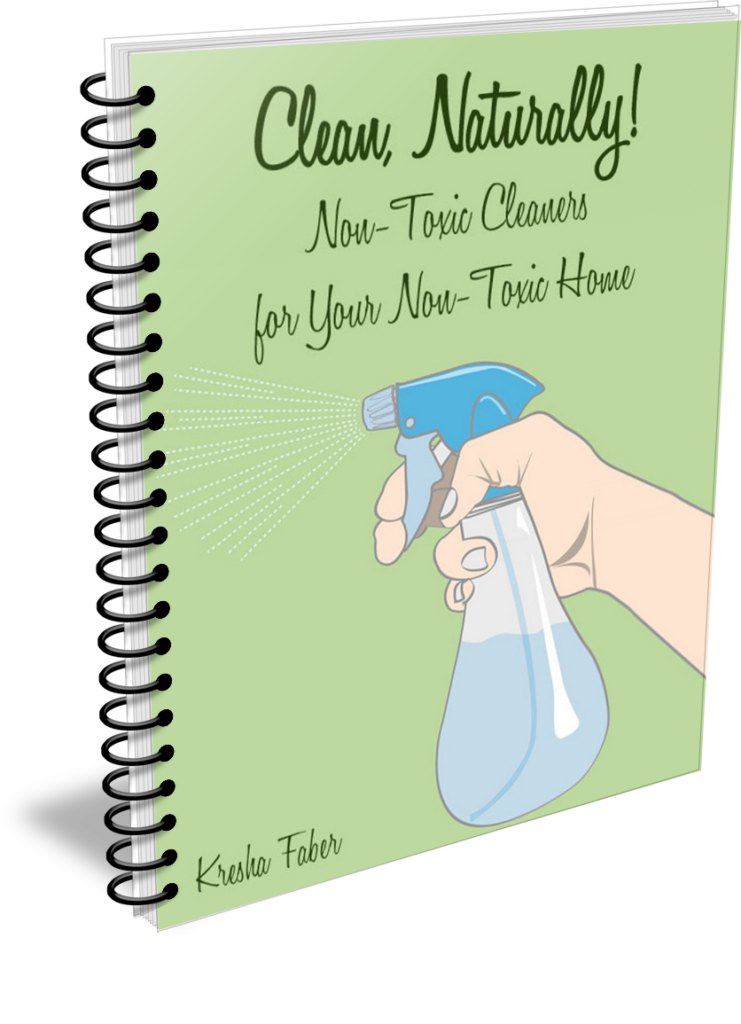



You shared amazing and helpful tips especially to those housewives who clean their house regularly. In addition to that we should also have a regular pest control service to avoid unwanted pest that may harm our family.
I LOVE all these tips and tricks!! one question: I find the white vinegar to smell for a long time…any suggestions on that? Cuz I love to use vinegar to clean!!!!
Not really, other than to open a window if the weather allows or to cut the vinegar with essential oils – you’ll still get the vinegar smell, but it’s a bit more balanced. Also, I don’t know how you typically use vinegar, but if you’re not already, perhaps put it in a spray bottle that will allow you to spray a fine spray rather than a heavy squirt. That will give good coverage to your surfaces as you clean while cutting back on the amount that’s used, which will reduce the scent as well.
And as a side note, I typically only smell vinegar for just a couple of minutes after I’ve finished, unless I sprayed it on carpet (then it will linger for quite awhile) or I used a ton of it. Otherwise, it seems to dissipate fairly quickly.
I hope that helps!
Yes put a few drops of you favorite essential oil
You can make homemade scented vinegars with mason jars. Simply place citrus rinds in the jar, fill with vinegar and steep for about 3 weeks. You can also use dried spruce branches, and do the same thing. They take about 6 weeks of steeping to infuse adequate scent.
I’m on the hunt for cleaning tips today and yours are more than helpful. Some of them are also rarely seen as you said yourself. #6 is my personal favourite.
I’m so glad they’re helpful! 🙂
I’ve learned for #6 that salt works well. I live in a rental that all the joints in the shower are caulked and there is no fan in the bathroom so we have issues with mildew growing quickly. I’ve learned that when I scrub the shower with canning/pickling salt the mildew stays away for weeks (even a month) vs. back in 2 days like with bleach. Beware of using it without gloves – ouch!
I also love using vinegar. That is all I use for cleaning my entire house. You don’t need alcohol to make a streak free mirror just 1/3 vinegar to 2/3 water in a spray bottle with a clean rag or paper towels.. Works great on laminate wood floors as well…a cup of vinegar, 1 tsp of dish soap and 2 1/2 gallons of water…fabulous!
I keep a mix of Costco brand mouth wash and peroxide ,50 50% mix in a spray bottle .After cleaning my washer ,dishwasher I spray that into the machines .I use it to clean out garbage cans sink drains it works great. I have a little blower,like a leaf blower but its little it’s a shop blower it is great for cleaning out clogs in the vacuum hose under fridge and washer and dryer and the lint catcher area of the dryer ,window tracks and filters for the house heater vacuum filters car air filters ETC., , Keeping those filters cleaned out will save you money ,and they work so much better. YOUR dryer will work so much better when the dryer hose is cleaned out. Angie
Thank you Kresha for these home cleaning tips. These were very helpful for me especially the 22nd tip in which you told how to clean stains from carpets.
Pretty much the same cleaning tips my mom taught me 40 years ago. Except the egg shells. Not sure how sanitary eggshells are for disenfecting and cleaning
Yes, that’s an excellent point, and I believe in the post I wrote about how to make a bathtub scrub out of eggshells (which is linked in this article), I outline how to clean your shells to make them sanitary. If I didn’t, the proper method is in the “how to make homemade calcium” post linked FROM the bathtub scrub recipe.
Do you know that you should never pour boiling water down drains with plastic plumbing! You can damage the seal. I know as this happened to my kitchen sink! Started dripping.
What brilliant hacks!! Thanks for sharing! I can’t wait to try them! ; )
Some decent tips in there, yes, but using eggshells to clean your bathtub is ill advised (mildly put). Eggshells are dangerously abrasive, so if someone wants to ruin their stuff in the hopes of getting an excuse to buy new stuff go for it. If you like your stuff leave the eggshells in your compost pile!
When finely pulverized, eggshells are no more abrasive than baking soda, pumice, feldspar, limestone, or soda ash that make up commercial soft scrubs. The difference is that – like pumice – they don’t dissolve, which is why they make such a great soft scrub, and they’re incredibly inexpensive.
Obviously, as is the case ANY time you make or buy a new product, test it on a small patch first if you’re concerned, but eggshells should not cause concern.
I totally agree with the cloth diaper suggestion. I still have a few left and my youngest is 32. When she “grew out” of diapers my wife wanted to give them to a friend. I told her that I had paid good money for those and I was keeping them for cleaning rags. After 20 years or so I think she finally agreed that they were worth keeping around. Don’t have many left but I think I got my money’s worth.
Your #1 tip I find to be very gross!! A USED washcloth on your faucet?? Do you realize where it has been? This is far from “clean” or sanitary.
No, not a washcloth. A handtowel. A dry, lightly-used one, at that. And only if it’s been out for one day, no one has come in with extra-grimy hands, and no one is sick. The towel is just to wipe up the stray beard hair trimmings, drips of toothpaste, and the other dirtiness that comes with daily use in order to makes faucets shine. You can also follow up with an all-purpose spray and another dry wipe-down if you like.
Of course, if it grosses you out, don’t do it!
Went to Branch Basics site today and they have suspended selling their concentrate until further notice.
🙁
Yes, it’s quite true. 🙁 Unbeknownst to them, their third-party supplier had falsified some claims, so even though the product is still safe, they have suspended sales until they find a new supplier they trust. While I appreciate their caution and their passion for transparency, I hope they resume sales soon – and wish I had stocked up a couple of months ago!
you are so smart!
cleaning kitchen is a hard work. butwith your tips, maybe it will not hard anymore..
Those natural ingredients, vinegar, baking soda, alcohol, and a spray bottle really make cleaning a breeze. Spray and rub. The real fun is in making your own cleaning solution and depending less on products.
Thank you for this tips! Before this article I only use alcohol for cleaning mirrors.
But now my knowlege is increased 🙂
I wanted to let you know that your link for Cloth Diapers goes to a Baby Monitor Camera thingy instead of Diapers 🙂
Oh, my goodness! Thank you so much for letting me know. I hate it when Amazon redirects links without letting me know…. ::sigh:: Off to see if I can find where they recategorized my favorite diapers…..
Thanks again!
Excellent article! I read your site regularly and I always find great info.
I shared this post on Facebook and my followers thought it
was great. Keep up the great work!
When you use a toothbrush to clean small areas, don’t forget to take it out of the bucket before pouring dirty water down the toilet…my husband has had to take ours apart 4 times because of that…one bathroom and 7 people, when the toilet is blocked is not fun!
Good reminder!!!!
Great article. Valuable tips.
So much informative article! I visit your site regularly and I always find great info. This article takes some good tips for me because in my kitchen Moss cover the wash basin on every side because of water leakage and I was worried about how to remove all this. I will use baking soda and non-toxic kitchen cleanser all over the inside or outside of our stainless steel sinks. thanks again for such good tips keep it up
I really enjoyed reading these tips. Some of them I will try.thank you very much
Hi Kresha! Great cleaning tips. I agree that salt is a great way to clean carpets as it will absorb the stain and is mild enough that you don’t have to worry about it discoloring the carpet. Have a great day and keep the cleaning tips coming.
Hi, I was wondering if the crayon wax on the hardwood floors is safe if we have a pooch around?
That should be no problem! You might look at the ingredient list of your particular brand of wax to make sure, but I can’t think of anything that should cause a problem.
Awesome advice! I always need more housecleaning tips. We have guests coming over next week. This breaks it down for people like me who hate cleaning! Thanks so much!
I have tried vodka to disinfect and freshen up the mattresses and It really works. Great cleaning tips you have shared. By following all these tips on the daily basis we can keep our home clean, healthy and dirt free.
Any tips on how to vacuum under the bed or how to clean under the bed. Thanks. Love your site
#7 mixing hydrogen peroxide and vinegar is a BIG mistake. It causes a noxious gas!!! Bad idea!!
To which noxious gas are you referring? Quite the contrary, although you’ll note that we call for keeping the two separate and using them simultaneously rather than mixing them, simply because they tend to react so quickly into paracetic acid once mixed that they render each other useless within a matter of hours if left mixed together.
During cleaning the home there are several of practices by which you can clean your home well as you can use the salt water to clean the surface as salt is the best combination to clean the room well and fully clean by the salt solution.
Lovely ideas and really helpful! I tried cleaning the shower head with vinegar and it really works – amazing.
Thanks for the great post on cleaning tips! I especially liked tip #24 about using a lint roller to dust cloth lampshades. I had no idea that was a thing!
A bunch of great and effective tips for every room in our house. Thanks for these tips!